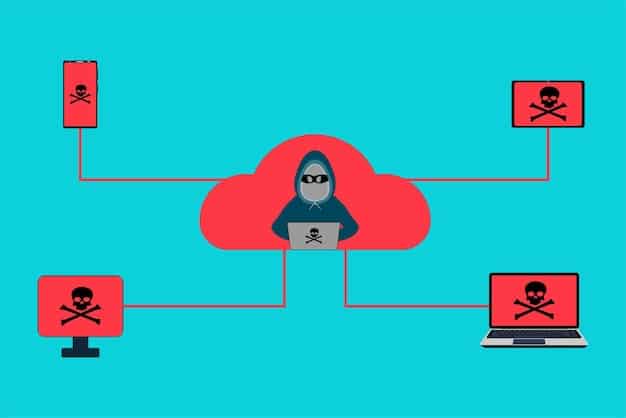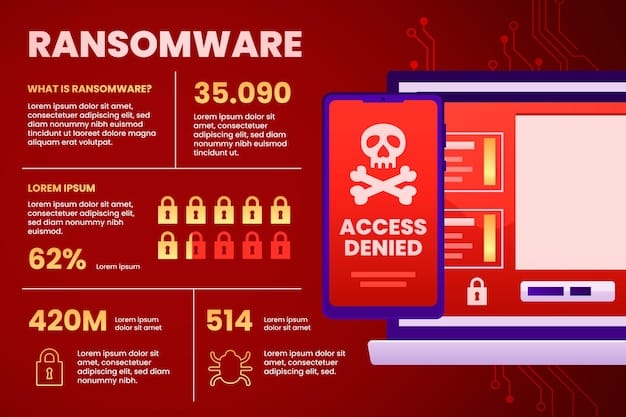Ransomware Attacks Surge: US Prevention and Recovery Strategies

Ransomware attacks in the US have surged by 15%, prompting a critical need for enhanced prevention strategies and robust recovery plans to protect businesses and individuals from these increasingly sophisticated cyber threats.
The United States has witnessed a concerning uptick in ransomware attacks, with a reported surge of 15%. This alarming trend underscores the urgent need for individuals and organizations to bolster their cybersecurity defenses and implement effective strategies to prevent and recover from these debilitating attacks. Are you prepared to protect your valuable data from falling victim to the next ransomware wave?
Understanding the Ransomware Threat Landscape in the US
The rise in ransomware attacks represents a significant challenge to cybersecurity in the United States. Understanding the nature of these threats, their impact, and the factors contributing to their prevalence is crucial for developing effective defense strategies.
What is Ransomware?
Ransomware is a type of malicious software that encrypts a victim’s files, rendering them inaccessible until a ransom is paid to the attacker. The ransomware demand typically comes with a deadline, increasing the pressure on the victim to comply.
Impact of Ransomware Attacks
The impact of a ransomware attack can be devastating, ranging from financial losses and reputational damage to operational disruptions and data breaches. Small and medium-sized businesses (SMBs) are particularly vulnerable, often lacking the resources and expertise to adequately protect themselves.
- Financial Losses: Ransom payments, recovery costs, and lost revenue can cripple organizations.
- Reputational Damage: Data breaches and service disruptions erode trust and confidence.
- Operational Disruptions: Critical systems and processes can be paralyzed, impacting productivity.
- Data Breaches: Sensitive information may be stolen and exposed, leading to legal and regulatory consequences.
Ransomware attacks are becoming increasingly sophisticated, targeting a wider range of organizations and industries. Staying informed about the latest threats and trends is essential for mitigating the risks associated with these attacks.

Analyzing the 15% Surge: Factors and Trends
The recent 15% surge in ransomware attacks in the US is a cause for serious concern. Several factors contribute to this increase, including evolving attack techniques, the rise of Ransomware-as-a-Service (RaaS), and the exploitation of vulnerabilities.
Evolving Attack Techniques
Ransomware attackers are constantly refining their methods, employing techniques such as double extortion (encrypting data and threatening to leak it) and leveraging vulnerabilities in supply chains to maximize their impact.
Ransomware-as-a-Service (RaaS)
The RaaS model has lowered the barrier to entry for cybercriminals, allowing even less skilled actors to launch ransomware attacks. This has led to a proliferation of ransomware variants and an increase in the overall volume of attacks.
- Lower Barrier to Entry: RaaS platforms provide ready-made tools and infrastructure for launching attacks.
- Increased Volume of Attacks: More actors are able to participate in ransomware campaigns.
- Greater Variety of Ransomware: RaaS fuels the creation of new ransomware variants.
Understanding these factors is crucial for developing proactive strategies to counter the rising tide of ransomware attacks. Organizations need to stay ahead of the curve by continuously assessing their vulnerabilities and adapting their defenses accordingly.
Proactive Prevention Strategies to Mitigate Risk
Preventing a ransomware attack is far more cost-effective than recovering from one. Implementing proactive cybersecurity measures can significantly reduce the risk of falling victim to these attacks.
Employee Training and Awareness
Human error is a leading cause of ransomware infections. Comprehensive employee training can help individuals recognize and avoid phishing scams, malicious links, and other common attack vectors.
Regular Security Audits and Assessments
Conducting regular security audits and vulnerability assessments can identify weaknesses in your infrastructure and systems, allowing you to address them before they can be exploited by attackers.
- Identify Vulnerabilities: Pinpoint weaknesses in your security posture.
- Implement Security Patches: Ensure all software is up-to-date with the latest security patches.
- Strengthen Network Security: Implement firewalls, intrusion detection systems, and other security controls.
By implementing these proactive prevention strategies, organizations can significantly reduce their risk of becoming a ransomware victim. A strong security posture requires ongoing vigilance and a commitment to continuous improvement.
Robust Recovery Plans: Ensuring Business Continuity
Despite the best prevention efforts, a ransomware attack can still occur. Having a robust recovery plan in place is essential for minimizing downtime and ensuring business continuity.
Data Backup and Recovery
Regularly backing up your data and storing it offline or in a secure cloud environment is crucial for recovering from a ransomware attack without paying the ransom. Ensure that your backups are tested regularly to verify their integrity.
Incident Response Plan
An incident response plan outlines the steps to take in the event of a ransomware attack. This includes isolating infected systems, notifying relevant stakeholders, and initiating the recovery process.
- Isolate Infected Systems: Prevent the ransomware from spreading to other devices.
- Notify Stakeholders: Inform employees, customers, and regulatory authorities, as necessary.
- Initiate Recovery Process: Restore data from backups and rebuild systems.
A well-defined and tested recovery plan can significantly reduce the impact of a ransomware attack, minimizing downtime and protecting your organization’s critical assets.

The Role of Cybersecurity Insurance in Mitigation
Cybersecurity insurance can provide financial protection and support in the event of a ransomware attack. While not a substitute for strong security measures, insurance can help organizations cover the costs of recovery, legal expenses, and ransom payments.
Coverage Considerations
When selecting a cybersecurity insurance policy, it’s important to consider the scope of coverage, including ransom payments, data recovery costs, business interruption losses, and legal fees.
Working with Insurance Providers
Insurance providers can also offer valuable resources and expertise to help organizations improve their cybersecurity posture. This may include access to incident response teams, forensic investigators, and legal counsel.
- Incident Response Support: Access to specialized teams to assist with recovery efforts.
- Forensic Investigations: Determine the root cause of the attack and identify vulnerabilities.
- Legal Counsel: Guidance on legal and regulatory requirements following a data breach.
Cybersecurity insurance can be a valuable tool for mitigating the financial impact of a ransomware attack. Organizations should carefully evaluate their needs and select a policy that provides adequate coverage and support.
Staying Ahead: Future Trends and Emerging Threats
The ransomware landscape is constantly evolving, with new threats and attack techniques emerging all the time. Staying informed about future trends and emerging threats is crucial for maintaining a strong security posture.
AI-Powered Attacks
Artificial intelligence (AI) is being used by cybercriminals to develop more sophisticated and targeted ransomware attacks. AI can be used to automate the discovery of vulnerabilities, craft more convincing phishing emails, and evade security defenses.
IoT Device Exploitation
The proliferation of Internet of Things (IoT) devices has created new opportunities for ransomware attackers. IoT devices often lack robust security controls, making them vulnerable to exploitation and use as entry points into corporate networks.
- Secure IoT Devices: Implement strong passwords and update firmware regularly.
- Network Segmentation: Isolate IoT devices from critical systems.
- Monitor Network Traffic: Detect suspicious activity and potential attacks.
By staying ahead of the curve and adapting their defenses to emerging threats, organizations can better protect themselves from the evolving ransomware landscape. Continuous learning and vigilance are essential for maintaining a strong security posture.
| Key Point | Brief Description |
|---|---|
| 🛡️ Prevention | Employee training and security audits are crucial. |
| 💾 Recovery | Data backups and incident response plans are essential. |
| 📈 Surge Factors | RaaS and evolving attack techniques drive increases. |
| 💡 Future Trends | AI and IoT device exploitation are emerging threats. |
Frequently Asked Questions (FAQ)
▼
Ransomware is malicious software that encrypts files on a device or network, making them inaccessible. Attackers then demand a ransom payment in exchange for the decryption key to restore access to the data.
▼
The surge is due to factors like the rise of Ransomware-as-a-Service (RaaS), which makes it easier for criminals to launch attacks, and increasingly sophisticated techniques that exploit vulnerabilities in systems.
▼
Best practices include employee training and awareness, regular security audits, strong password policies, up-to-date software patches, and implementing multi-factor authentication (MFA) where possible.
▼
Immediately isolate the infected device from the network, notify your IT department or cybersecurity team, and implement your incident response plan. Contact law enforcement and consider consulting with a cybersecurity expert.
▼
Yes, many cybersecurity insurance policies cover ransomware attacks, including ransom payments, data recovery costs, and business interruption losses. Review your policy details for specific coverage.
Conclusion
The 15% surge in ransomware attacks in the US is a clear indicator of the evolving threat landscape. By implementing proactive prevention strategies, developing robust recovery plans, and staying informed about emerging threats, individuals and organizations can significantly reduce their risk and protect their valuable data from these increasingly sophisticated attacks.




